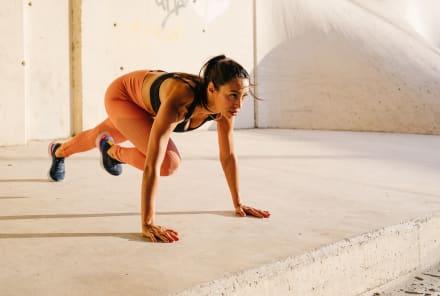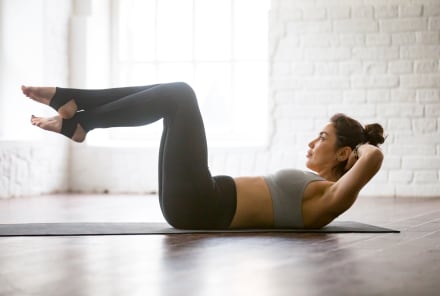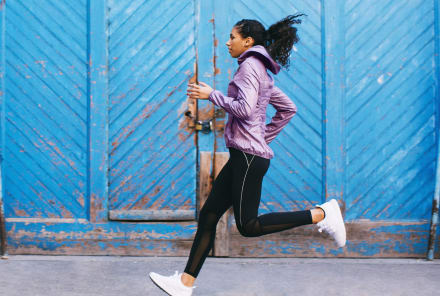Advertisement
I Tried 12 Weeks of Strength Training For Perimenopause & Here's What Happened

One of the most beneficial things women can do for their bodies at any time, but especially in perimenopause and beyond, is to build muscle mass.
Indeed, after 12 weeks of weight lifting three times a week at age 45, I can confirm that the muscle I've gained has been a perimenopause game-changer. It's also transformed my relationship with my body and the number on the scale.
Here's an overview of my experience, including why I started lifting, how my body changed over time, how muscle mass eased my menopausal transition, and some tips I have to share from the journey.
Why I stopped prioritizing cardio over building strength
I've long had a regular fitness routine. But like many women, I'd always prioritized cardio over building strength. Why? First, I like cardio. Nothing soothes my soul like a meditative run in the woods, and it's great for helping me manage my asthma.
But also, if you look at health advice and research from the '80s, '90s, and the aughts, you'll find the notion that weight management and chronic disease prevention is about calories-in-calories-out1, or burning more calories than you consume. Thanks to newer research2, we can now label that concept a myth.
The quantity of calories matters, of course. But the most important aspect of nutrition is about the nutrient quality3 of what we eat. In short, weight management and overall health are much more complicated than simple math. They involve complex hormonal processes that are tied to our metabolic health status.
Why muscle mass helps during menopause
Being metabolic healthy means having optimal levels4 of blood pressure, fasting glucose, waist circumference, triglycerides, and high density lipoprotein (HDL), or what's called "good" cholesterol—all without taking medication to control these factors.
Poor metabolic health is linked to lots of issues, but one that may surprise you is that it's associated with worse menopausal symptoms5. However, improved metabolic health may help ease5 symptoms. And guess what helps make us more metabolically healthy? Muscle mass6.
I knew I needed to be gaining muscle rather than losing it. So that’s what I set out to do—not to lose weight but to ensure that my body stays metabolically healthy.
Perimenopause usually begins in one's 40s7, and it can last for a decade before one reaches menopause, which is the absence of a period for 12 months, usually occurring in one's early 50s7. After that, you're in postmenopause. Perimenopause is when we often notice menopausal symptoms, such as weight gain, depression, anxiety, sleep issues, hot flashes and night sweats, and more.
Many of these symptoms occur because of changes in hormones, all of which I won't get into here. But, as an example, by the time we reach menopause, estrogen levels will have declined by as much as 50%8. Estrogen helps protect us from insulin resistance9, and research shows that insulin resistance often increases around menopause.
Plus, insulin resistance and weight gain are linked. Often, excess weight can lead to insulin resistance, and vice versa. Other hormonal changes during perimenopause impact our feelings of hunger or fullness. These are some of the many reasons menopause can be associated with midlife weight gain.
Perimenopause10, and the corresponding decline in estrogen, is traditionally a time when we gain fat and lose muscle. This changes our shape, but it also puts us even more at risk for insulin resistance and other health concerns, and it contributes to further changes in hunger and satiety signals. Muscle loss can also lead to11 joint pain, frailty, osteoporosis, and more, leaving us feeling lackluster, to say the least. But it doesn't have to be this way.
Muscle is more metabolically healthy10 than fat. It can increase our insulin sensitivity, increase the amount of calories we burn at rest, promote fat loss, and aid in balancing hunger and satiety signals12. As an added bonus, lean body mass, meaning muscle, may be protective against or ease some menopausal symptoms.
After learning all of this, I was sold. I knew I needed to be gaining muscle rather than losing it. So that's what I set out to do—not to lose weight but to ensure that my body stays metabolically healthy, which can also boost my longevity and keep me feeling (and looking) my best in my later years.
What 12 weeks of weightlifting did for me
I started out with the goal to lift three times a week for 12 weeks before reassessing. As of the writing of this article, I'm actually close to reaching 24 weeks, but I want to focus on what happened to me during those first three months. Twelve weeks is an accessible goal and goes slightly beyond the average time13 it takes to form a habit.
One caveat: I'm not going to discuss weight. Aside from gaining muscle, I wasn't focused on changing the number on the scale. However, I will note that, as a big plus, weight has now become irrelevant to me.
- 3 weeks: My favorite jeans fit better. I have more energy. I have less back and hip pain while sitting. My body feels firmer.
- 6 weeks: Everyday lifting (like slinging a giant bag of cat food or shoving my roller into the overhead bin) is becoming easier. Consuming enough protein to build muscle has been challenging for this veggie lover, but I'm finally getting the hang of it with lots of whey supplementation.
- 9 weeks: The new habit is locked in. My core feels not just flat but solid. I'm sleeping better. Hot flashes pass more quickly and are less intense. My clothes fit even better. I can see and feel body composition changes, especially in my arms, core, and thighs.
- 12 weeks: I'm eager to continue the progress. I've never felt fitter, despite having trained for and raced several marathons and one triathlon. I barely notice that I'm in perimenopause, whereas before weightlifting, I was acutely aware of certain symptoms.
Tips for beginning strength training
Here's how I took some of the pain points out of getting started and went about achieving my goal:
- Figure out your equipment. I am not a gym person. So I invested in a set of adjustable weights that take up minimal space. Not having to leave the house took away excuses for me. But I also vowed to hit the hotel gym while traveling for work.
- Make a plan. Going in with a plan takes the guesswork out of each workout. I watched dumbbell lifting tutorials and made a list of moves to target my whole body each session. I perform these for 8 to 12 reps at the highest weight possible without sacrificing form. I aim for only two sets to avoid burnout, but I target each muscle (e.g., triceps, biceps, quads) with at least two different moves per session. I go through my whole circuit of moves before tackling the second round. This saves on rest time, and working through the exercises faster gives me a cardio boost.
- Aim for progressive overload. If I've hit 12 reps for a move, I go up in weight for my next session even if I can't quite do 8 reps. If I'm staying at the same weight, I increase the rep number. Progressive overload14 forces your muscles to adapt by getting stronger and bigger.
- Track your progress. I use a spreadsheet on my phone and note the weight, reps, and sets for each move. Seeing my progress over time has been seriously motivating.
- Prioritize protein. The recommended dietary allowance15 of protein is 0.8 gram per kilogram of body weight. But that's the minimum you need to maintain health. To build muscle, you need more for protein synthesis. As someone getting regular intense physical activity, I now aim for 1.6 grams per kilogram of bodyweight and opt for protein that is high enough in all the essential amino acids.
- Keep it interesting. At the 12-week mark, I changed up my routine, leveling up certain moves and swapping others altogether.
- Practice progress, not perfection. Consistency is key, but perfection is impossible. Ultimately, I know life will catch up with me from time to time, so rest will happen naturally. That's why I typically don't plan rest days in my routine. Instead, I plan active rest with steady-state cardio or yoga in between lifting sessions. That way, when I'm forced to take a break because of a migraine attack, illness, or what have you, I don't feel guilty about it. I offer myself some grace and get at it again when I can.
- Focus on nutrient-dense foods. Muscle is just one part of the equation. Our bodies need optimal levels of vitamins and minerals to support metabolic health. I aim to eat for stable blood sugar by packing my plate with veggies, fruit, healthy fats, and protein. I avoid, as much as possible, added sugar, processed carbs, and ultra-processed items.
The takeaway
I'm so glad I've added weightlifting to my routine. While I first picked up the iron to ease perimenopause symptoms, I know that lifting will now be a lifelong habit for me. My only regret is not starting earlier. If you're ready to begin or progress your weight training, check out this approachable guide to resistance training.
15 Sources
- https://www.ncbi.nlm.nih.gov/pmc/articles/PMC5916427/
- https://www.ncbi.nlm.nih.gov/pmc/articles/PMC5639963/
- https://jamanetwork.com/journals/jamainternalmedicine/article-abstract/2686146
- https://pubmed.ncbi.nlm.nih.gov/30484738/
- https://www.sciencedirect.com/science/article/pii/S1521693423000482
- https://pubmed.ncbi.nlm.nih.gov/34235892/
- https://www.ncbi.nlm.nih.gov/pmc/articles/PMC3285482/
- https://pubmed.ncbi.nlm.nih.gov/18624962/
- https://www.nature.com/articles/s41366-021-01022-x
- https://www.ncbi.nlm.nih.gov/pmc/articles/PMC3661116/
- https://link.springer.com/article/10.1007/s13224-019-01213-7
- https://pubmed.ncbi.nlm.nih.gov/30934678/
- https://www.ncbi.nlm.nih.gov/pmc/articles/PMC3505409/
- https://pubmed.ncbi.nlm.nih.gov/28834797/
- https://pubmed.ncbi.nlm.nih.gov/26797090/

Short On Time? Try This Personal Trainer's 5-Minute Full-Body Workout
Krista Stryker, NSCA-CPT

Short On Time? Try This Personal Trainer's 5-Minute Full-Body Workout
Krista Stryker, NSCA-CPT

Short On Time? Try This Personal Trainer's 5-Minute Full-Body Workout
Krista Stryker, NSCA-CPT

Short On Time? Try This Personal Trainer's 5-Minute Full-Body Workout
Krista Stryker, NSCA-CPT









